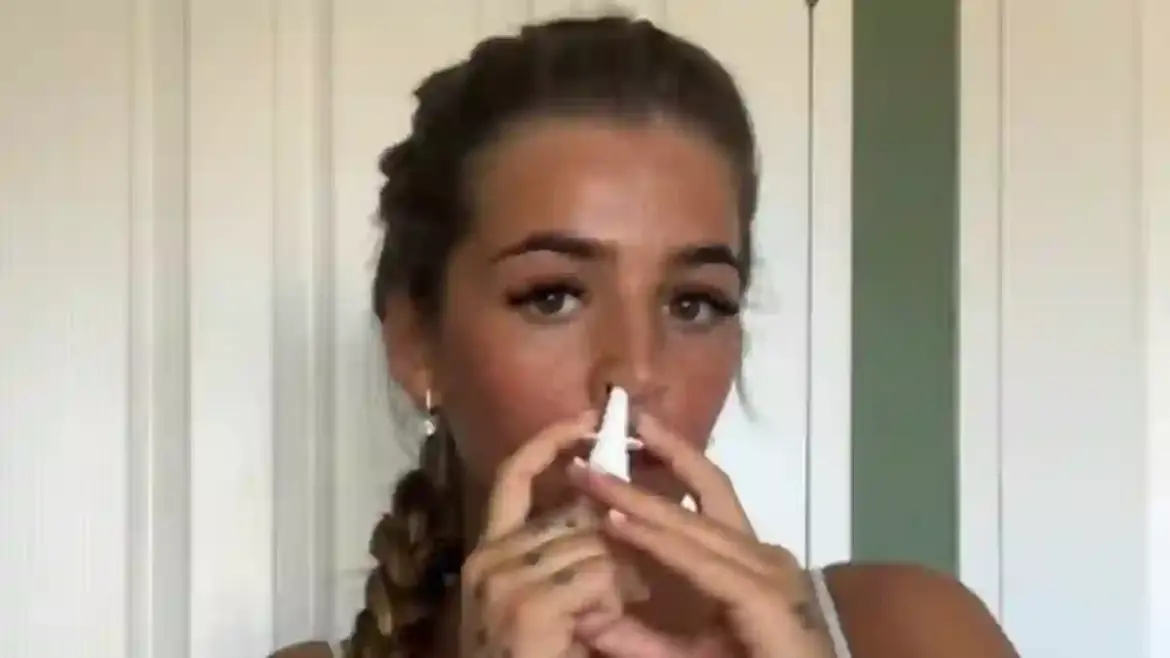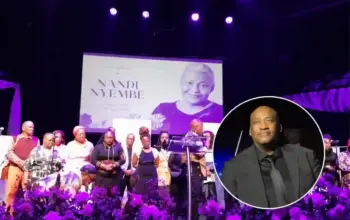Scrolling through TikTok, it’s hard to miss the endless stream of tanning routines promising flawless, sun-kissed skin.
One video, in particular, caught attention: a young blonde woman in her 20s beams at the camera, demonstrating her so-called “tan routine.” But this isn’t your typical sunbathing or self-tanner trick—it’s far more extreme.
She holds a small white bottle filled with amber liquid, inserts the tip into her nostrils, pumps, and inhales deeply.
Smiling for the camera, she poses as if showing off a new fashion accessory. Later, she walks into a sunbed salon, filming herself inside the bed.
The video concludes with a revealing shot showing the stark contrast between her deeply tanned skin and her naturally pale complexion.
Her caption reads, “My tan routine ❤️ everyone always asks how I’m so tanned.” The clip has been liked over 21,000 times, with viewers clamoring to know what brand of nasal spray she’s using.
Extreme Tanning Trends Are on the Rise
A quick TikTok search for #sunbed yields millions of videos.
Many young women are now supplementing their sunbed sessions with nasal tanning sprays, entering what experts call the world of “extreme tanning.”
Here, synthetic hormones are inhaled or injected to intensify a tan—often with little knowledge of the ingredients or risks involved.
You might never have heard of nasal tanning sprays or tanning injections, but many of these products contain melanotan II, a synthetic compound that mimics a natural hormone called melanocyte-stimulating hormone (MSH).
MSH stimulates melanin production when your skin is exposed to UV light, darkening your skin.
Nasal sprays and injections simulate this process without actual sun exposure.
Young Users Share Their Experiences
Pearl Koster, 22, from Surrey, started using sunbeds at 18 and tried nasal sprays while working at a tanning salon in April.
Her TikTok video showing her routine has 15,000 likes, captioned: “You’re so tanned! Thanks, I spend £50 a week on sunbeds and spray melatonin up my nose.”
She laughs when she admits the caption mistakenly says “melatonin,” a sleep hormone, rather than the likely melanotan II.
“This is the thing,” she says. “No one really knows what’s in these sprays.
Everyone corrected me in the comments.” Pearl first tried the spray after a staff member offered her a free sample.
“I used nasals for a couple of months, and yes, they do make you really dark,” she admits.
Health Risks and the Legal Grey Zone
Sunbeds have long been known to carry serious health risks.
By 2010, the government banned their use for under-18s, and tanning salons declined significantly by 2013. Yet recent research suggests usage is rising again.
Melanoma Focus, a charity, found that 42% of 18 to 25-year-olds have used sunbeds—and many intensify their tan with sprays or injections.
Melanotan II is illegal for cosmetic use in the UK. Richard Knight, from the Chartered Trading Standards Institute, warns that these unlicensed products haven’t undergone proper safety testing.
Side effects can include respiratory issues, high blood pressure, nausea, vomiting, skin changes, kidney problems, and links to cancer.
“The long-term effects are unknown,” Knight says bluntly.
The Tragic Consequences
Last month, Femail shared the story of Paige Phillips, a 24-year-old who combined nasal sprays with sunbed sessions.
She developed a rare melanoma in the roof of her mouth that eventually spread to her neck, lungs, and brain.
Paige endured grueling treatments for two years before dying in March.
Her mother, Debbie, believes the tanning sprays and sunbeds were the cause.
Despite these tragedies, TikTok videos continue to circulate, promoting these products—sometimes with commission incentives—further fueling the trend.
Ignorance and Addiction Fuel the Trend
Pearl acknowledges the dangers but admits the appeal is hard to resist.
“There are no ingredients listed, so you don’t know what you’re getting into. Sunbeds are bad enough; I know I shouldn’t be adding to it.”
Her motivation is strikingly familiar: “I genuinely feel prettier when I’m tanned. I feel ugly when I’m pale.
My sister calls it ‘tan dysmorphia.’ Even though I know it’s bad, they [nasal sprays] do work—that’s why they’re addictive.”
The ease of purchase only worsens the problem. Online marketplaces like TikTok Shop make it shockingly simple to buy nasal sprays with sweet flavors and misleading labels.
Misleading Marketing and Unsafe Products
Some products claim to be “cosmetic tanning lotions” but arrive as nasal sprays, often with instructions for multiple daily doses.
Websites promoting melanotan II make false claims about “protecting your skin” and tanning safely, which medical experts vehemently reject. Dr. Ross Perry warns: “If we overuse melanin, we change our skin’s DNA, age prematurely, and increase cancer risk.
There’s no quality assurance and inhaling it can trigger severe allergic reactions.”
Regulatory Challenges
Tanning injections fall under the MHRA’s jurisdiction, but nasal sprays exist in a legal grey area, often imported from the US, making enforcement difficult.
Consumers’ rights under general product safety law are still being ignored, leaving many vulnerable to unsafe products.
Dr. Catherine Borysiewicz, a dermatologist, laments: “The number of young people using sunbeds is astronomical.
We could be heading for a complete crisis. Every dermatologist hopes these sprays and sunbeds will be banned.”
A Chilling Reminder
As summer fades, the temptation to maintain a deep tan with nasal sprays or injections continues.
For those chasing a sun-kissed glow at any cost, the consequences can be severe—even deadly.
The tragic story of Paige Phillips serves as a stark warning: extreme tanning may seem harmless on social media, but the risks behind the filter are all too real.



